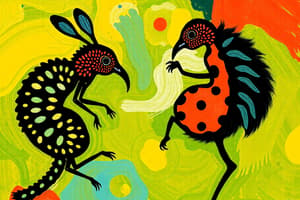Podcast
Questions and Answers
Describe the different methods of asexual reproduction in animals.
Describe the different methods of asexual reproduction in animals.
Asexual reproduction in animals can occur through methods such as budding, fission, and regeneration, where a new organism is produced from a single parent without the involvement of gametes.
What are the advantages and disadvantages of sexual and asexual reproduction in animals?
What are the advantages and disadvantages of sexual and asexual reproduction in animals?
Sexual reproduction allows for genetic diversity but requires the investment of time and energy in finding a mate, while asexual reproduction produces offspring quickly but may result in limited genetic variation and potential vulnerability to environmental changes.
Explain the process of sexual reproduction in animals.
Explain the process of sexual reproduction in animals.
Sexual reproduction in animals involves the fusion of male and female gametes to form a zygote, which then develops into a new organism.
Flashcards are hidden until you start studying
Study Notes
Asexual Reproduction in Animals
- Fission: a process where an individual divides into two or more identical individuals, e.g., binary fission in certain worms and starfish.
- Budding: a new individual grows from a part of the parent's body, e.g., Hydra and certain corals.
- Fragmentation: an individual breaks into fragments, each of which grows into a new individual, e.g., certain worms and sea stars.
- Regeneration: lost or damaged body parts are replaced, e.g., some insects, fish, and amphibians.
- Parthenogenesis: an offspring develops from an unfertilized egg, e.g., some species of wasps, bees, and fish.
Advantages and Disadvantages of Reproductive Methods
Asexual Reproduction
- Advantages: rapid population growth, adaptation to favorable environments, and no need for mates or genetic variation.
- Disadvantages: lack of genetic diversity, susceptibility to diseases, and limited adaptation to changing environments.
Sexual Reproduction
- Advantages: increases genetic diversity, adapts to changing environments, and promotes evolution.
- Disadvantages: slower population growth, requires mates, and is energetically costly.
Sexual Reproduction in Animals
- Meiosis: the process of gamete formation, involving two successive cell divisions, resulting in four haploid gametes.
- Fertilization: the fusion of a sperm and an egg, resulting in a diploid zygote.
- Gametogenesis: the process of gamete formation, involving meiosis and maturation.
- Copulation: the process of gamete transfer, e.g., mating behaviors in animals.
- Embryonic development: the growth and development of a zygote into a fully formed offspring.
Studying That Suits You
Use AI to generate personalized quizzes and flashcards to suit your learning preferences.




